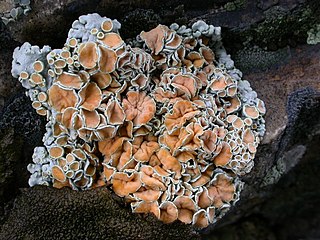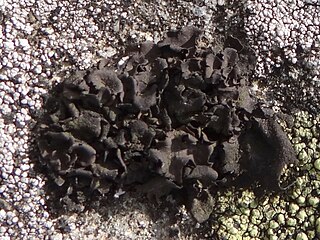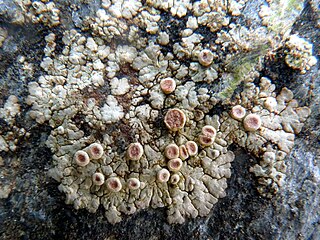
Umbilicaria esculenta, the rock tripe or Iwa-take, is a lichen of the genus Umbilicaria that grows on rocks.

Rhizoplaca is a genus of lichenized fungi in the family Lecanoraceae. Members of the genus are commonly called rimmed navel lichens because of their umbilicate growth form and lecanorine apothecia, also rock-posy lichen and rockbright.
Neobrownliella brownlieae is a species of saxicolous (rock-dwelling), crustose lichen in the family Teloschistaceae. It is widely distributed in Australia.

Lichens are symbiotic organisms made up of multiple species: a fungus, one or more photobionts and sometimes a yeast. They are regularly grouped by their external appearance – a characteristic known as their growth form. This form, which is based on the appearance of vegetative part of the lichen, varies depending on the species and the environmental conditions it faces. Those who study lichens (lichenologists) have described a dozen of these forms: areolate, byssoid, calicioid, cladoniform, crustose, filamentous, foliose, fruticose, gelatinous, leprose, placoidioid and squamulose. Traditionally, crustose (flat), foliose (leafy) and fruticose (shrubby) are considered to be the three main forms. In addition to these more formalised, traditional growth types, there are a handful of informal types named for their resemblance to the lichens of specific genera. These include alectorioid, catapyrenioid, cetrarioid, hypogymnioid, parmelioid and usneoid.

Lecanora muralis(Protoparmeliopsis muralis) is a waxy looking, pale yellowish green crustose lichen that usually grows in rosettes radiating from a center (placodioid) filled with disc-like yellowish-tan fruiting bodies (apothecia). It grows all over the world. It is extremely variable in its characteristics as a single taxon, and may represent a complex of species. The fruiting body parts have rims of tissue similar to that of the main nonfruiting body (thallus), which is called being lecanorine. It is paler and greener than L. mellea, and more yellow than L. sierrae. In California, it may be the most common member of the Lecanora genus found growing on rocks (saxicolous).

Umbilicaria phaea is a brown, umbilicate foliose lichen that grows up to 6 cm (2.4 in) in diameter, sometimes in colonies covering large patches of desert rocks. One variety that grows in northern California is brilliant red. It is (monophyllous) with a single 1 – 5 cm flattish leaf-like cap on top of an anchoring stem (umbilicate). The leaflike top is smooth with some lobes, roughly circular, thin, and brittle. The lower surface is light gray to light brown. It has up to 2.5 mm black circular to slightly polygonal spots that are the fruiting bodies (apothecia), slightly sunken into the main nonfruiting body part (thallus). It grows on siliceous boulders in very dry climates of western North and South America, where it is usually the most common member of its genus.

Umbilicaria polyphylla, commonly known as petaled rock tripe, is a widely distributed species of saxicolous lichen in the family Umbilicariaceae. It was first described by Carl Linnaeus in his 1753 work Species Plantarum as Lichen polyphyllus. German botanist Johann Christian Gottlob Baumgarten transferred it to the genus Umbilicaria in 1790. The lichen has a dark brown to black thallus that measures 2–6 cm (0.8–2.4 in) in diameter. The upper surface is smooth, while the lower surface is sooty black. It grows on exposed rocks, typically in arctic-alpine habitats.

Umbilicaria deusta, commonly known as peppered rock tripe, is a widely distributed species of saxicolous lichen in the family Umbilicariaceae. It was first described by Carl Linnaeus in his 1753 work Species Plantarum as Lichen polyphyllus. German botanist Johann Christian Gottlob Baumgarten transferred it to the genus Umbilicaria in 1790. The lichen has a dark brown to nearly black thallus that typically measures 1–5 cm (0.4–2.0 in) in diameter. The upper surface is covered with tiny black dots that are granular isidia; the lower surface is the same colour as the upper surface, and is either smooth or covereds with dimples. It grows on exposed boulders and rocky outcrops.

Umbilicaria hyperborea, commonly known as blistered rock tripe, is a species of foliose lichen in the family Umbilicariaceae. It is widely distributed in arctic and alpine regions.

Punctelia graminicola is a species of foliose (leafy) lichen in the family Parmeliaceae. It grows on rocks, and, less frequently, on bark in North America, South America, and East Africa. It has a blue-grey thallus measuring up to about 15 cm (6 in), covered with tiny pores called pseudocyphellae. Sometimes the lichen forms small lobes that project out from the surface. Fruiting bodies are uncommon in this species; if present, they resemble small cups with a brown internal disc measuring 3–10 mm (0.1–0.4 in) in diameter. A lookalike species, Punctelia hypoleucites, is not readily distinguishable from Punctelia graminicola by appearance or habitat alone; these species can only be reliably differentiated by examining the length of their conidia.
Remototrachyna sipmaniana is a species of saxicolous (rock-dwelling), foliose lichen in the family Parmeliaceae. It is only known to occur in Bolivia, where it grows on boulders in Yungas mountain cloud forests.

Umbilicaria virginis, commonly known as the blushing rock tripe, is a species of saxicolous (rock-dwelling) umbilicate lichen in the family Umbilicariaceae. It occurs in polar and alpine regions.
Umbilicaria maculata is a species of saxicolous (rock-dwelling) umbilicate lichen in the family Umbilicariaceae. It is found in high-elevation alpine locations in Poland and France.
Umbilicaria murihikuana is a rare species of saxicolous (rock-dwelling) lichen in the family Umbilicariaceae. It is endemic to New Zealand, where it occurs in mountainous, high-rainfall areas of Otago and Southland. It grows on exposed rocks and boulders at altitudes between 1,000 and 1,500 m, in subalpine to alpine habitats.

Placopsis lambii is a species of saxicolous (rock-dwelling), crustose lichen in the family Trapeliaceae. It was formally described as a new species in 1987 by lichenologists Hannes Hertel and Volkmar Wirth. The species epithet lambii honours polar explorer and lichenologist Elke Mackenzie. In North America, one vernacular name for the lichen is pink bull's-eye lichen.
Lempholemma polycarpum is a little-known species of saxicolous (rock-dwelling) lichen in the family Lichinaceae. It was first described from Yemen and is characterised by its blackish thallus, abundant small apothecia, and cyanobacteria from the genus Nostoc as its photobiont. The lichen is found on inclined limestone boulders in sun-exposed habitats with open forest vegetation. It also occurs in Madagascar and in Aldabra.

Polycauliona bolacina, the waxy firedot lichen, is a species of saxicolous (rock-dwelling), crustose lichen in the family Teloschistaceae. It is found in western North America.

Flavoplaca oasis is a species of saxicolous (rock-dwelling), crustose lichen in the family Teloschistaceae. It is widely distributed across Europe, and has been reported in Western Asia, China, and North Africa.

Pyxine petricola is a species of saxicolous (rock-dwelling), foliose lichen in the family Caliciaceae. The distribution of the lichen includes Australia, East Africa, North and Central America, and the Philippines.














